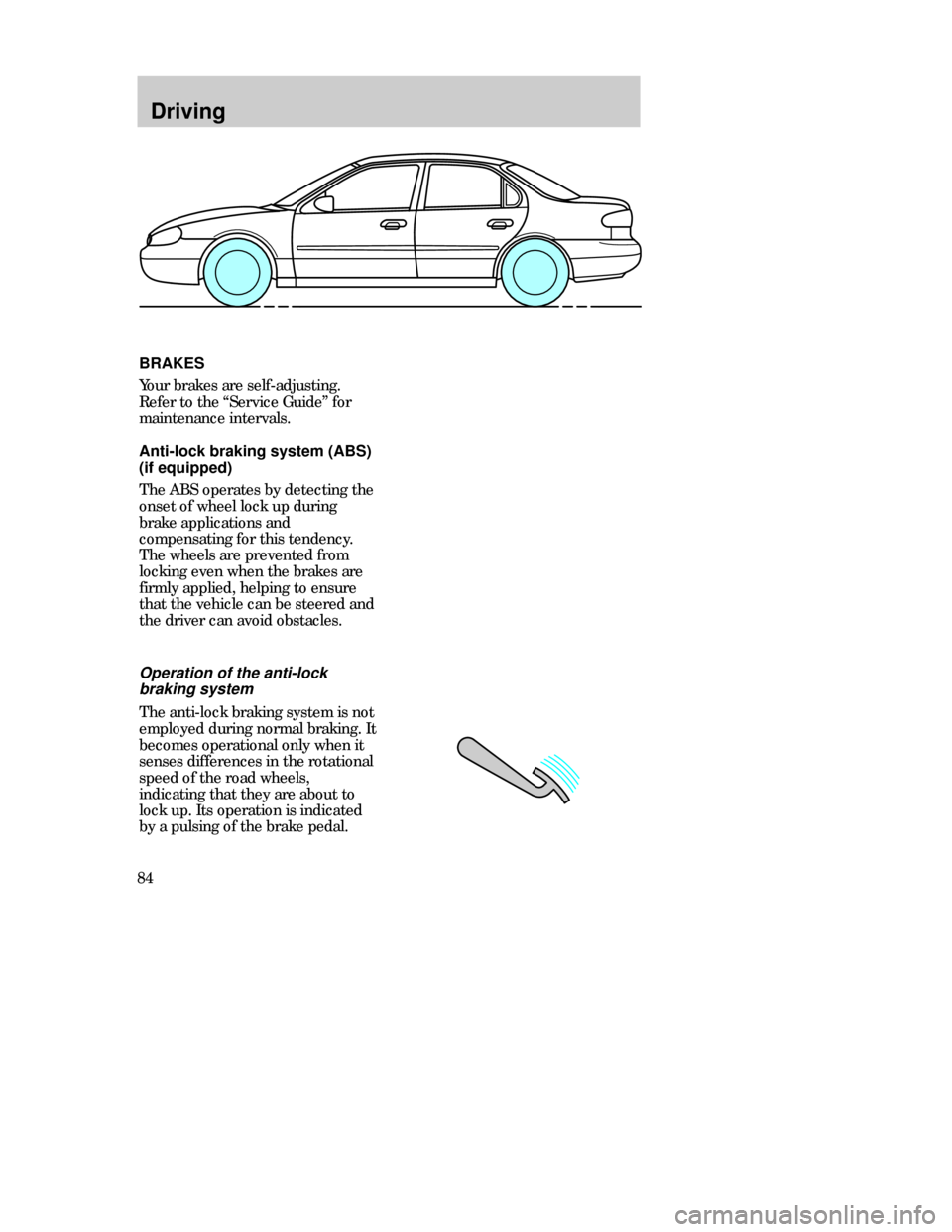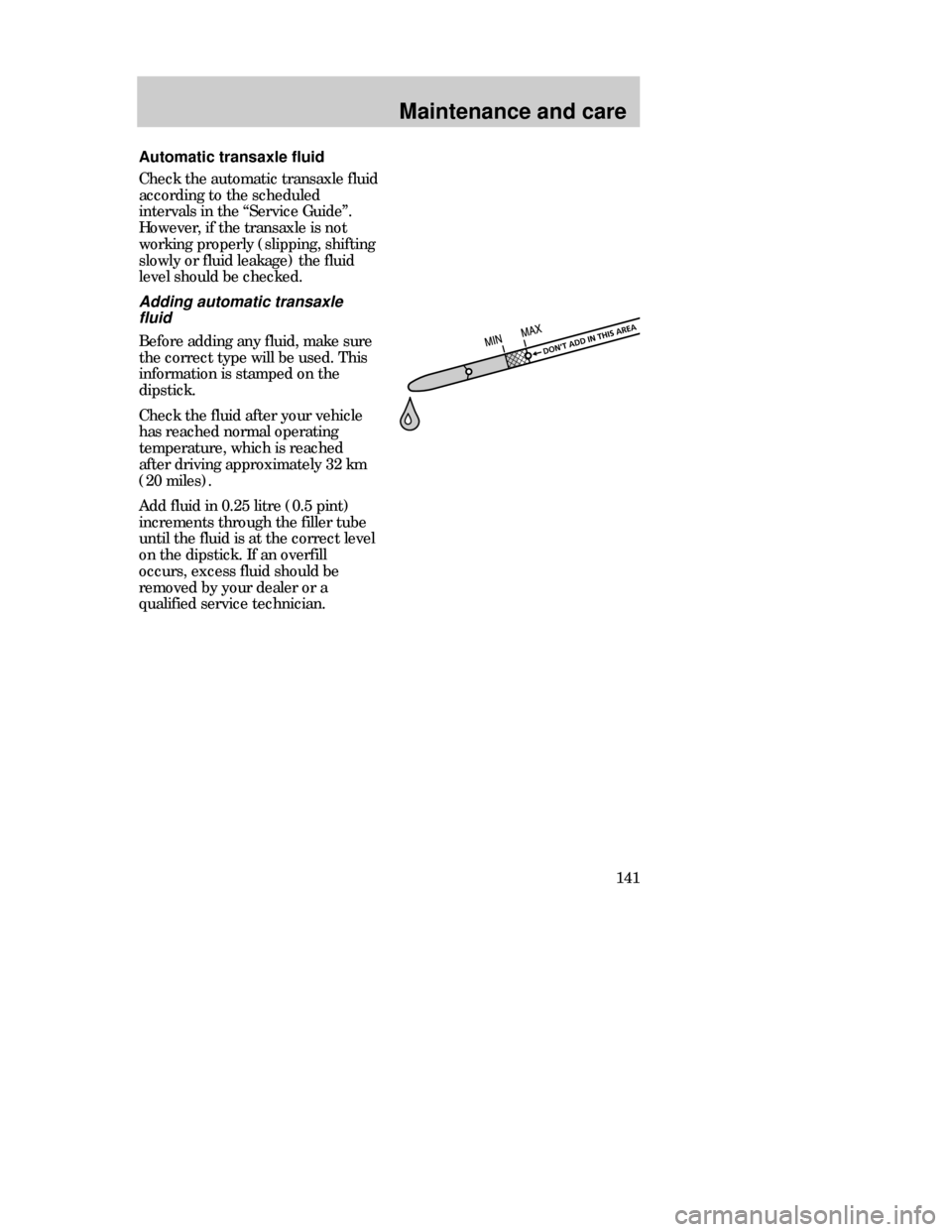service interval Mercury Mystique 1998 Owner's Manuals
[x] Cancel search | Manufacturer: MERCURY, Model Year: 1998, Model line: Mystique, Model: Mercury Mystique 1998Pages: 196, PDF Size: 1.65 MB
Page 84 of 196

Driving
84BRAKES
Your brakes are self-adjusting.
Refer to the “Service Guide” for
maintenance intervals.
Anti-lock braking system (ABS)
(if equipped)
The ABS operates by detecting the
onset of wheel lock up during
brake applications and
compensating for this tendency.
The wheels are prevented from
locking even when the brakes are
firmly applied, helping to ensure
that the vehicle can be steered and
the driver can avoid obstacles.
Operation of the anti-lock
braking system
The anti-lock braking system is not
employed during normal braking. It
becomes operational only when it
senses differences in the rotational
speed of the road wheels,
indicating that they are about to
lock up. Its operation is indicated
by a pulsing of the brake pedal.
CDW IVB1-10Driving en MM 5/15/97 7:51 PM Page 84
Page 139 of 196

Maintenance and care
139
MAX
MIN
Adding engine coolant
1. Before removing the engine
coolant recovery cap, turn the
engine off and allow it to cool.
2. When the engine is cool, turn
and remove the cap.
•Step back for a moment while the
pressure in the reservoir is
released.
•Stand away from the reservoir
opening. Hot steam or coolant
spray may be released.
3. Add engine coolant until the
fluid level in the reservoir is
between the MAX and MIN lines on
the reservoir.
Follow the recommended service
interval for changing engine
coolant as outlined in the “Service
Guide”. Refer to Capacities and
specifications for more
information on engine coolant
specifications.
Have your dealer or a qualified
service technician check the engine
coolant system for leaks if you have
to add more than a litre (quart) of
engine coolant per month.
Never remove the coolant
recovery cap while the
engine is running or hot.
CDW VA1-19Maint en MM 5/15/97 7:55 PM Page 139
Page 141 of 196

Maintenance and care
141 Automatic transaxle fluid
Check the automatic transaxle fluid
according to the scheduled
intervals in the “Service Guide”.
However, if the transaxle is not
working properly (slipping, shifting
slowly or fluid leakage) the fluid
level should be checked.
Adding automatic transaxle
fluid
Before adding any fluid, make sure
the correct type will be used. This
information is stamped on the
dipstick.
Check the fluid after your vehicle
has reached normal operating
temperature, which is reached
after driving approximately 32 km
(20 miles).
Add fluid in 0.25 litre (0.5 pint)
increments through the filler tube
until the fluid is at the correct level
on the dipstick. If an overfill
occurs, excess fluid should be
removed by your dealer or a
qualified service technician.
CDW VA1-19Maint en MM 5/15/97 7:56 PM Page 141
Page 152 of 196

Maintenance and care
152Checking tire pressure
Check the tire pressure
periodically and inflate the tires as
necessary. To check the tire
pressure, insert the tire pressure
gauge into the valve.
The cold pressure amount is listed
on the Safety Compliance
Certification label.
Improperly inflated tires can
affect vehicle handling and
can fail suddenly, possibly
resulting in loss of vehicle control.
Rotating tires
Rotate your tires at regular
intervals for even wear. Rotation
intervals are listed in the “Service
Guide”.
CDW VA1-19Maint en MM 5/15/97 7:56 PM Page 152
Page 163 of 196

Maintenance and care
163 WHAT YOU SHOULD KNOW
ABOUT THE EMISSION
CONTROLSYSTEM
For more information about your
vehicle’s emission control system,
refer to the Vehicle Emission
Control Information Decal located
on the inside, left of the engine
compartment.
The catalytic converter enables the
vehicle’s emission control system to
operate properly.
Follow these guidelines to ensure
proper emission system operation:
•Use unleaded fuel only.
•Avoid running out of fuel.
EF 1
/
2
UNLEADED FUEL ONLY
• Do not turn off the ignition while
your vehicle is in motion.
•Have maintenance performed
according to intervals in the
“Service Guide”.
Exhaust leaks may result in
the entry of harmful and
potentially lethal fumes into the
passenger compartment. Under
extreme conditions excessive
exhaust temperatures could
damage the fuel system, the
interior floor covering, or other
vehicle components, possibly
causing a fire.
CDW VA1-19Maint en MM 5/15/97 7:56 PM Page 163